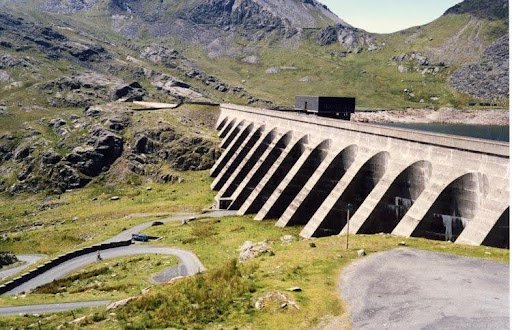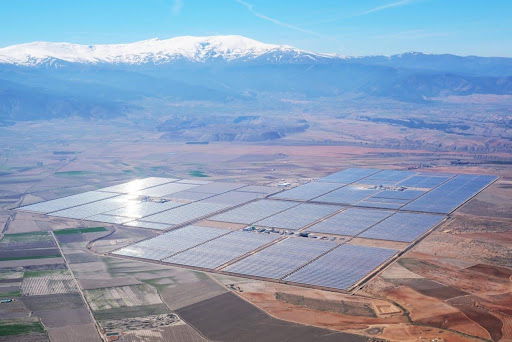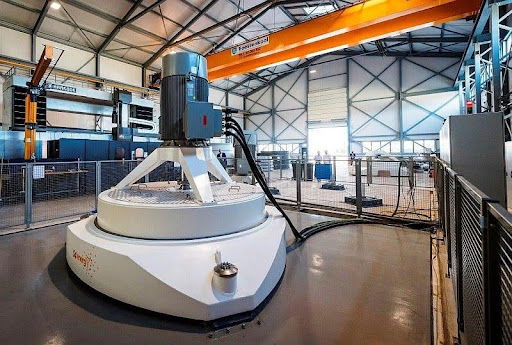Stocking up for future use (II/II): how energy storage technologies work


· 6 min read
This is part two of a two-part series on energy storage technologies. You can find part one here.
This second part of our exploration into energy storage technologies ventures into the realms of physics-based methods such as hydroelectric dams, pumped storage power plants, flywheels, and compressed air energy storage, alongside innovative approaches like gravitational energy storage and molten salt for heat. These technologies highlight the diverse strategies being pursued to tackle the challenge of storing energy for future use, ensuring a more sustainable, reliable, and efficient energy supply in the face of increasing renewable energy integration.
But what if we turn not to chemistry, but to physics? Humanity has figured out how to use gravity, rotational energy, and compressed air pressure to store electricity.
A hydroelectric dam (HPP) stores the potential gravitational energy of water: the liquid accumulated in reservoirs is discharged from a great height and rotates the blades of a generator, which converts mechanical energy into electrical energy. A more complex option is pumped storage power plants (PSPPs). They allow you to spend energy more evenly throughout the day, reducing the load on the power grid. During peak hours, energy costs go up, and at night, when energy consumption is low, energy is much cheaper. At night, the pumped storage power plant receives cheap electricity from the grid and uses it by pumping water upward using pumps, and during the morning and evening peaks in energy consumption, the water is discharged onto the generator blades. This generates expensive electricity, which is sent to the network.

The upper reservoir and dam of the Ffestiniog pumped storage station in North Wales
PSPPs are good when it is necessary to provide electricity to populated areas. Such systems can store large amounts of electricity for several hours, but at the same time do not allow large amounts of energy to be quickly withdrawn to cope with a short-term network failure.
However, the use of pumped storage power plants will increase in the coming years. In the United States, they plan to turn the picturesque San Vicente Reservoir in San Diego into a giant “water accumulator”. China is expanding its network of pumped storage power plants: At the beginning of 2022, the world’s largest pumped storage power plant began operating in Hebei province, and by 2025 they plan to build 200 pumped hydroelectric power plants with a total capacity of 270 gigawatts.
In addition to hydroelectric power plants and pumped storage power plants, gravity is also used in railway storage tanks. In early 2022, Fortescue Future Industries announced the creation of an electric train, the Infinity Train, to transport iron ore. Its battery will be recharged thanks to gravity — in other words, the train will serve as a gravitational battery for itself.

Infinity Train — a train with gravitational energy storage
Another way to conserve electricity is to convert it into the kinetic energy of the rotation of a massive wheel (flywheel). When energy needs to be stored, the mechanism that consumes electricity from an external source accelerates the flywheel. And vice versa: when an electric machine goes into generator mode, the rotational energy of the flywheel is converted into electrical energy and sent to the network, while the flywheel slows down.
Finally, compressed air pressure helps in storing electricity in large quantities. Cheap electricity can be spent by pumping air into a special storage tank using an electric motor. When electricity is needed, compressed air is released from the storage tank and rotates the generator turbine.
The sun’s energy can also be converted into heat and stored in this form for some time. Molten salt, for example, can hold energy. The salt is first heated using heliostats — sun-focused mirrors that collect heat from sunlight. It is then sent to the tank and powers the steam generator as needed. The resulting steam rotates a turbine, which generates electricity. This technology helps supply electricity to homes in the evenings.

The 150 MW Andasol solar power plant in Spain stores energy in molten salt tanks
According to economists, by 2040 the global market for energy storage systems (excluding pumped storage power plants) will grow 122 times from the 2018 level, and their total capacity will exceed the threshold of 1000 GW, and energy — 2,850 GWh. Today, the total capacity of energy storage systems in the world is approximately 150 GWh.
The most important parameters for storage devices are power factor, charge-discharge time, storage duration, and implementation cost. It must be taken into account that maintaining their operation — maintaining a suitable temperature or converting energy — also requires resources. Therefore, electrochemical storage devices look the most promising today. Other drive options are only being developed, and if used, then in experimental mode.
The problem with a power-to-gas system is that between 19 and 33 percent of energy is lost during electrolysis. In addition, electrolysis is a fairly expensive process. In particular, to reduce energy costs and speed up the reaction, catalysts based on platinum group metals, mainly platinum and palladium, are used. Today, it is advisable to use power-to-gas technology only for long-term energy storage. Finally, transporting hydrogen is also a complex undertaking, with risks of leaks and explosions when exposed to oxygen.
Companies from all over the world are developing hybrid systems that combine the advantages and compensate for the disadvantages of different types of drives. For example, in the Netherlands, since 2020, hybrids made of lithium-ion batteries and flywheels from the Dutch company S4 Energy have been operating. According to the developers, the use of lithium-ion batteries in combination with flywheels extends battery life to at least 15 years.

The KINEXT flywheel from S4 Systems is part of a hybrid energy storage system. S4 Energy
Energy storage systems are not a new technology. After all, battery prototypes date back to the 19th century. However, storage has only relatively recently become efficient enough to overcome the inherent disadvantages of renewable energy. The use of such systems allows us to reduce carbon dioxide emissions and expand the use of alternative energy sources, which means bringing the world closer to an environmentally friendly future.
Future Thought Leaders is a democratic space presenting the thoughts and opinions of rising Sustainability & Energy writers, their opinions do not necessarily represent those of illuminem.
illuminem

Construction Tech · Green Tech
illuminem briefings

Geothermal · AI
illuminem briefings

AI · Green Tech
The Guardian

Electric Vehicles · Public Governance
The Economist

AI · Green Tech
Electrek

Battery · Energy Sources